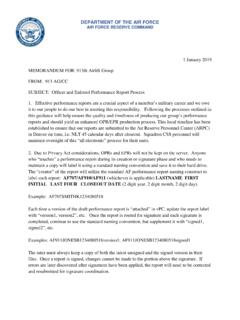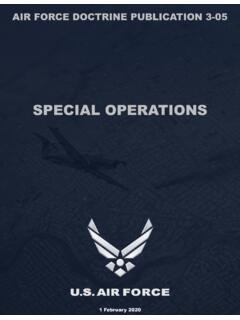Transcription of U.S. Army Short-Range Air Defense Force Structure and ...
1 Army Short-Range Air Defense Force Structure and Selected Programs: Background and Issues for Congress July 23, 2020 Congressional Research Service R46463 Congressional Research Service SUMMARY Army Short-Range Air Defense Force Structure and Selected Programs: Background and Issues for Congress The Army defines Short-Range Air Defense (SHORAD) as dedicated air Defense artillery (ADA) and non-dedicated air Defense capabilities that enable movement and maneuver by destroying, neutralizing or deterring low altitude air threats to defend critical fixed and semi-fixed assets and maneuver forces. SHORAD units were historically embedded in Army divisions, providing them with an organic capability to protect their critical assets against fixed-wing and rotary-wing aircraft. However, in the early 2000s, these ADA units were divested from the Army to meet Force demands deemed more critical at that time. Decisionmakers accepted the increased risk that threat aircraft might pose to ground forces and other critical assets because they believed the Air Force could maintain air superiority.
2 Since 2005 though, there has been a significant increase in air and missile platforms arrayed against ground forces. The use of unmanned aerial systems (UASs) by both state and non-state actors has increased exponentially, and UASs have been used successfully by both sides in the Russo-Ukrainian conflict. Fixed-wing aircraft, attack helicopters, and cruise missiles also continue to pose a significant threat to ground forces, as do rockets, artillery, and mortars (RAM). Recognizing ground Force vulnerability to these threats, the Army has embarked on an effort to revitalize and update its SHORAD forces and associated systems. Eventually the Army plans to have 10 Maneuver (M)-SHORAD battalions to defend maneuver units and other critical assets within each of the Army s divisions. The battalions are planned to be created incrementally over time. The Army is also planning to stand up eight Indirect Fire Protection Capability (IFPC) units five in the Active Component (AC) and three in the Army National Guard (ARNG to defend fixed and semi-fixed assets at corps and division-level.)
3 In terms of SHORAD systems modernization, the Army is developing a Maneuver SHORAD (M-SHORAD) system based on existing SHORAD capabilities and concurrently developing a directed-energy version (DE) M-SHORAD. The Army is also updating legacy radars and developing new SHORAD radar systems and an Integrated Air and Missile Defense Battle command System (IBCS) to provide command and control of both SHORAD units and missile Defense . To help protect ground forces from various types of attacks, Congress mandated in the John S. McCain National Defense Authorization Act for Fiscal Year 2019 ( 115-232) and the Department of Defense Appropriations Act for Fiscal Year 2019 ( 115-245) that the Army acquire four Israeli-developed Iron Dome batteries. The Iron Dome system is a dual-mission counter rocket, artillery, and mortar (C-RAM) and a Short-Range air Defense system used to target and destroy missiles with an approximate range of 7 70 km. While the Marines were successful in initial tests integrating Iron Dome with their SHORAD systems, the Army said they have had significant interoperability issues with Iron Dome and expressed doubts that Iron Dome would be an effective system against higher end cruise missiles.
4 Potential issues for Congress include, but are not limited to, the following: Should there be a legislative provision on future divestment of SHORAD capability? Is the Army s modernization priority for SHORAD appropriate? Is the Army allocating sufficient resources to revitalize SHORAD? Are planned SHORAD Force Structure and capabilities adequate to meet predicted future challenges? What is the future of Iron Dome and its effectiveness against advanced cruise missiles? Is Army SHORAD compatible with Marine Corps SHORAD? R46463 July 23, 2020 Andrew Feickert Specialist in Military Ground Forces Army Short-Range Air Defense Force Structure and Selected Programs Congressional Research Service Contents Why Is this Issue Important for Congress? .. 1 What Is Short Range Air Defense (SHORAD)? .. 1 Recent History and Current State of Army SHORAD .. 1 Renewed Emphasis on SHORAD .. 2 Army Categories of UAS .. 2 Growing the SHORAD Force .. 3 Current Army SHORAD Modernization Plans.
5 3 Selected Legacy and Developmental SHORAD Systems .. 4 Selected Legacy Systems .. 4 Stinger .. 4 Avenger .. 5 Land-Based Phalanx Weapons System (LPWS) .. 7 AN/MPQ-64 Sentinel A3 Radar .. 8 Selected Developmental 9 Maneuver Short Range Air Defense (M-SHORAD) .. 9 Indirect Fire Protection Capability (IFPC) Increment 2 (Inc 2) .. 10 Iron Dome .. 12 Background .. 12 Characteristics .. 12 Claims of Iron Dome Performance in Combat .. 13 Administration and Congressional Interest in Iron Dome .. 13 Army Reverses Its Iron Dome Procurement Decision .. 14 Marine Corps Success with Iron Dome Integration .. 15 Congressional Reaction .. 15 FY2021 National Defense Authorization Act (NDAA) .. 15 Army s Current Position on Iron Dome .. 16 Integrated Air and Missile Defense Battle command Systems (IBCS) .. 17 AN/MPQ-64 Sentinel A4 Radar .. 19 Directed Energy (DE) M-SHORAD .. 20 Potential Issues for 22 Should There Be a Legislative Provision on Future Divestment of SHOARD Capability?
6 22 Is the Army s Modernization Priority for SHORAD Appropriate? .. 22 Is the Army Allocating Sufficient Resources to Revitalize SHORAD? .. 23 Are Planned SHORAD Force Structure and Capabilities Adequate to Meet Predicted Future Challenges? .. 24 What Is the Future of Iron Dome and Its Effectiveness Against Cruise Missiles? .. 25 Is Army SHORAD Compatible with Marine Corps SHORAD? .. 26 Figures Figure 1. FIM-92 Stinger Man-Portable, Air Defense Missile System .. 5 Figure SHORAD System .. 6 Figure Phalanx Weapons System (LPWS) .. 7 Figure Sentinel A3 Radar .. 8 Army Short-Range Air Defense Force Structure and Selected Programs Congressional Research Service Figure SHORAD .. 10 Figure 6. Prototype IFPC Inc 2 12 Figure 7. Israel s Iron Dome System .. 17 Figure Air and Missile Defense Battle command Systems (IBCS) .. 19 Figure 9. AN/MPQ-64 Sentinel A4 Radar .. 20 Figure s Conception: Directed Energy (DE) M-SHORAD .. 21 Figure 11. FY2021 Army Budget Allocation, by Capability Portfolio.
7 24 Tables Table 1. Army Categories of Unmanned Aerial Systems (UAS) .. 3 Contacts Author Information .. 26 Army Short-Range Air Defense Force Structure and Selected Programs Congressional Research Service 1 Why Is this Issue Important for Congress? Congress is responsible for funding the Army, establishing rules for its regulation, and conducting oversight of a number of Army functions including manning, equipping, training, and readiness. With the growing state and non-state threats of unmanned aerial systems (UASs), cruise missiles (CM), rockets, artillery, and mortar (RAM), as well as traditional fixed and rotary wing aircraft, congressional oversight of the Army s ability to counter these threats could take on an even more important role. To help protect ground forces from these potential attacks in the near term, Congress has mandated the Army acquire four Israeli-developed Iron Dome batteries in both the John S. McCain National Defense Authorization Act for Fiscal Year 2019 and the Defense Appropriations Act for Fiscal Year 2019 ( 115-232 and 115-245).
8 There have, however, been Army concerns with Iron Dome, and some in Congress have expressed their dissatisfaction with both the Secretary of Defense and Secretary of the Army on the issue. With the Army s overall modernization plans for the total Force and associated plans to rebuild SHORAD Force Structure , upgrade existing systems, and develop new systems, Congress might have to decide if the Army s SHORAD modernization effort is affordable and if the Army is allocating sufficient resources towards the end goal. What Is Short Range Air Defense (SHORAD)? The Army defines SHORAD as: Dedicated air Defense artillery (ADA) and non-dedicated air Defense capabilities that enable movement and maneuver by destroying, neutralizing or deterring low altitude air threats to defend critical fixed and semi-fixed assets and maneuver As originally envisioned prior to and during the Cold War, low-altitude air threats consisted of enemy ground attack fixed-wing aircraft and attack helicopters.
9 As military technology advanced over time, and as cruise missiles and unmanned aerial systems began to proliferate, these systems were also categorized as low-altitude air threats. While mortars, artillery, and rockets have long been a threat on the battlefield, it is only over the past few decades that military technology has progressed to the point where incoming shells and missiles can be detected, engaged, and destroyed with a relatively high degree of success. As such, mortars, artillery, and rockets are now also included as part of low-altitude air threats and are the responsibility of SHORAD systems and units. Recent History and Current State of Army SHORAD In 2017, the Army summarized the recent history and current state of Army SHORAD: Short-Range air Defense artillery units were historically embedded in Army divisions, providing them with an organic capability to protect their critical assets against fixed-wing and rotary-wing aircraft. However, in the early 2000s, these ADA units were divested from the Army to meet Force demands deemed more critical at that time.
10 Decision-makers accepted the risk that threat aircraft might have on maneuver forces and other critical assets because we believed the Air Force could maintain air superiority. Thus, the Short-Range ADA Force post-2005 was reduced to two battalions of active component Avenger and counter-rocket, artillery and mortar batteries and seven National Guard Avenger 1 , accessed July 17, 2020. Army Short-Range Air Defense Force Structure and Selected Programs Congressional Research Service 2 battalions; none of which are organic divisional elements. Defense against air threats in maneuver forces is currently limited to that provided by organic weapons and maneuver According to the Army, the reduction in active component SHORAD battalions was necessary because the Army needed this Force Structure to grow maneuver brigade combat teams for counter-insurgency operations. 3 Renewed Emphasis on SHORAD Since 2005, potential threats from air and missile platforms that could threaten ground forces have significantly increased.
















